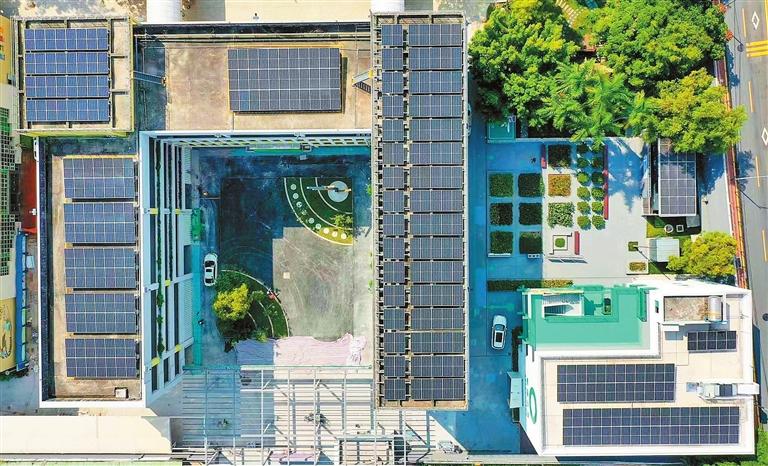

Wang Jingli wangjingli0715@163.com LIULIAN Primary School in Longgang District, which can generate its own electricity, was recently reported by China Central Television (CCTV). After a facelift that ended at the end of July, the school became China’s first PEDF primary school and Shenzhen’s first near zero-energy primary school renovated from existing buildings. What is PEDF? PEDF simply refers to four technologies, which are photovoltaic, energy storage, direct current and flexibility. Specifically, “P” means solar photovoltaic power generation system in the building area. “E” means energy storage devices in the power supply system to store excess energy and release it when needed. “D” means a simple, easy-to-control, transmission high-efficiency direct current power supply system and “F” means the building’s flexibility to actively adjust the power drawn from the municipal grid. Through the juxtaposition and integrated utilization of multiple technologies, the energy-saving and low-carbon operation of the buildings can be realized. The most unique feature of a PEDF building is that a flexible power consumption management system is used to realize the self-regulation and self-optimization of building power consumption, which provides an effective solution for alleviating the shortage of power supply, according to a report by China State Construction which constructed the world’s first operational PEDF building in Shenshan Special Cooperation Zone in 2021. Old school turns green Founded in 1985, Liulian now becomes a smart school after the renovation. According to Xu Dinghua, head of the school’s administrative office, the project adopted new materials to upgrade the enclosure system, reducing building energy consumption and significantly improving indoor thermal comfort. In order to further improve the energy-saving effect, the school has also upgraded its old air-conditioning system to achieve AI energy saving and achieved intelligent lighting. Moreover, it used direct current lamps and fans to reduce energy consumption. “After the renovation, the entire campus can save 28,000 kWh of electricity and reduce carbon dioxide emissions by 13 metric tons per year, which is equivalent to planting 3,250 trees,” Xu said. With the use of algorithms, photovoltaic panels installed on building roofs help increase power generation by 5% to 30%, generating 145,000 kWh of electricity each year. Supplying power to other parts of city “We can not only supply electricity to our own school, but also to the city,” Xu said proudly. “We are like a power bank.” In addition to achieving self-sufficiency in power supply, the school can also perform energy conversion and storage through a gray structure known as “Energy Cube,” which serves as the energy control hub for the entire campus. At the first China PEDF conference this year, the school was named one of the top 10 PEDF cases by the China Association of Building Energy Efficiency. Low-carbon classes The green project also provides an opportunity for the school to spread green and low-carbon knowledge. Students are encouraged to cultivate representative plants with high carbon sequestration value. At corridors, there are low-carbon education signs and paintings. Classes on information technology and new energy supply are given to students. During an open day held recently, the school gave every child a seed to plant in its Carbon Fixation Garden. “We hope students could better understand and practice these green ideas and then help promote low carbon and zero carbon ideas to their parents and society,” said Xiang Yong, deputy director of the school’s moral education department. | 
